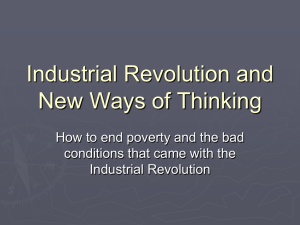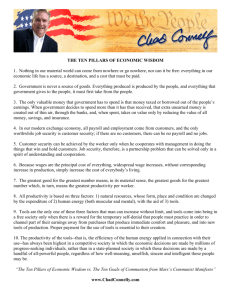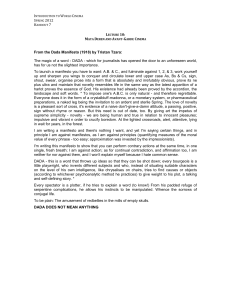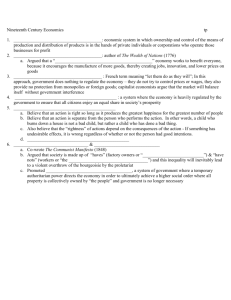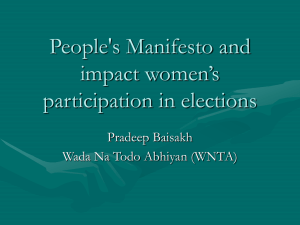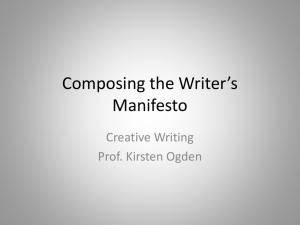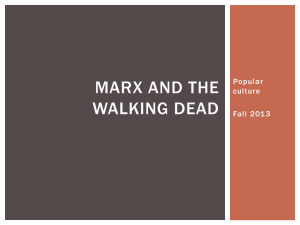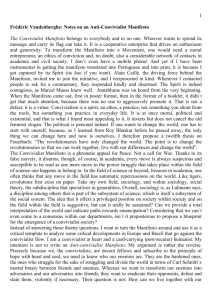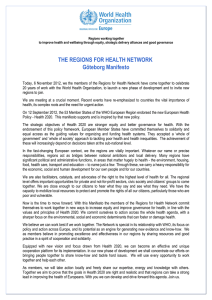The Communist Manifesto As Historical And
advertisement
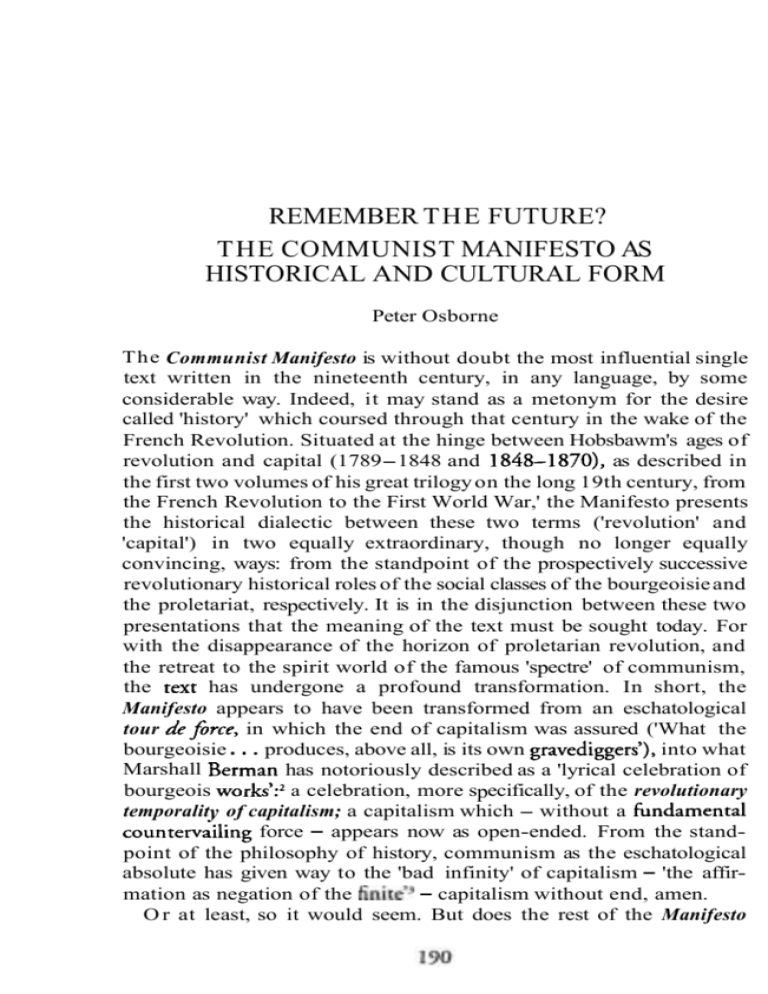
REMEMBER THE FUTURE?
THE COMMUNIST MANIFESTO AS
HISTORICAL AND CULTURAL FORM
Peter Osborne
The Communist Manifesto is without doubt the most influential single
text written in the nineteenth century, in any language, by some
considerable way. Indeed, it may stand as a metonym for the desire
called 'history' which coursed through that century in the wake of the
French Revolution. Situated at the hinge between Hobsbawm's ages of
revolution and capital (1789-1848 and 1848-1870), as described in
the first two volumes of his great trilogy on the long 19th century, from
the French Revolution to the First World War,' the Manifesto presents
the historical dialectic between these two terms ('revolution' and
'capital') in two equally extraordinary, though no longer equally
convincing, ways: from the standpoint of the prospectively successive
revolutionary historical roles of the social classes of the bourgeoisie and
the proletariat, respectively. It is in the disjunction between these two
presentations that the meaning of the text must be sought today. For
with the disappearance of the horizon of proletarian revolution, and
the retreat to the spirit world of the famous 'spectre' of communism,
the text has undergone a profound transformation. In short, the
Manifesto appears to have been transformed from an eschatological
tour &force, in which the end of capitalism was assured ('What the
bourgeoisie . produces, above all, is its own gavedigger<), into what
Marshall Berman has notoriously described as a 'lyrical celebration of
bourgeois works'? a celebration, more specifically, of the revolutionary
temporality of capitalism; a capitalism which - without a hndamental
countervailing force - appears now as open-ended. From the standpoint of the philosophy of history, communism as the eschatological
absolute has given way to the 'bad infinity' of capitalism - 'the affirmation as negation of the finite'3- capitalism without end, amen.
O r at least, so it would seem. But does the rest of the Manifesto
..
PETER OSBORNE
191
belong unambiguously to a shape of life grown old? O r is there another
sense in which it is still a 'living' text, afier the fall of historical
communism? Is there, perhaps, new life in it today? What lives in the
Communist Manifesto? In particular - and this is the question I shall
address here - what is the temporal character of its address to us,
citizen-subjects of Western capitalist democracies? How does it
inscribe us into historical time, today?4
1. T H E POETRY OF TRANSITION
Let me quote what is probably - in the wake of Marshall Berman's
path-breaking work - the most cited passage from the Communist
Manifesto, in a Western academic context, over the last 15 years:
The bourgeoisie, historically, has played a most revolutionary part. The
bourgeoisie, wherever it has got the upper hand, has put an end to all feudal, patriarchal, idyllic relations. It has pitilessly torn asunder the motley feudal ties that
bound men and women to their 'natural superiors', and has left remaining no other
nexus between people than naked self-interest, than callous 'cash payment'. It has
drowned the most heavenly ecstasies of religious fervour, of chivalrous enthusiasm,
of philistine sentimentalism, in the icy waters of egotistical calculation. It has
resolved personal worth into exchange value, and in place of the numberless
indefeasible chartered freedoms, has set up that single, unconscionable freedom Free Trade. In one word, for exploitation, veiled by religious and political illusions,
it has substituted naked, shameless, direct brutal exploitation. [. . . The
bourgeoisie] has been the first to show what human activity can bring abour. It has
accomplished wonders far surpassing Egyptian pyramids, Roman aqueducts, and
Gothic cathedrals; it has conducted expeditions that put in the shade all former
Exoduses of nations and crusades.
And now, what is for Berman the most important part:
The bourgeoisie cannot exist without constantly revolutionising the instruments of
production, and thereby the relations of production, and with them the whole
relations of society. Conservation of the old modes of production in unaltered
form, was, on the contrary, the first condition of existence for all earlier industrial
classes. Constant revolutionising of production, uninterrupted disturbance of all
social conditions, everlasting uncertainty and agitation distinguish the bourgeois
epoch from all earlier ones. All fixed, fast-frozen relations, with their train of
ancient and venerable prejudices and opinions, are swept away, all new-formed ones
become antiquated before they can ossify. All that is solid melts into air, all that is
holy is profaned, and men and women are at last compelled to face with sober
senses, their real conditions of life, and their relations with their kind.5
More specifically, according to Marx in the passage which follows, this
192
THE SOCIALIST REGISTER 1998
'constant revolutionising' has three main effects: economic and cultural
globalization; subjection of the countryside to the towns; and political
centralization in the form of new state-led or state-created nations.
What is this but - as Berman describes it in the subtitle of his fine book
- 'the experience of modernity'?
The culture of capital is the systemic instantiation of a
Mephistophelean spirit of negation. And what is the Communist
Manifesto from the standpoint of such a negation - a Manifesto
without belief in the world-historical agency of the working classes,
and with an acknowledgement of the powers of states and capitals to
contain what had appeared to Marx as ultimately unmanageable crises;
what is the Communist Manifesto in this context - in which the
'sorcerer' of modern society has regained a certain crucial measure of
control over its powers - but, as Berman puts it, 'the archetype of a
century of modernist manifestoes and movements to come . . the first
great modernist work of art'zb When, in his Preface to the 1893 Italian
edition of the Manifesto, Engels wrote of Dante as 'both the last poet
of the Middle Ages and the first poet of modern times', in order to
conjure the prospect of the 'new Dante, who will mark the hour of
birth of this new proletarian era', he was appealing to national
sentiment in Italy. Yet it is hard to read this passage without imputing
a reference (if only unconscious) to Marx and to the Manifesto itself.
However, if the era that was approaching was not in fact a proletarian
one, but rather one of capitalism on a !global scale, what does Marx
become, if not the poet of the transition to capitalism; a prefiguration,
in epic mode, of Baudelaire and Flaubert? The Manifesto appears as a
work of modernist historiography: the experience of mid nineteenthcentury European capitalism, writ large.
As Berman argues, the Manifesto's prose is driven by, and expresses
in dissident form, a relentless temporal logic of negation, which
derives, historically, from the logic of capital itself. Once the historically-specific political demands, and corresponding social content, of
such a manifesto are set aside or judged to be superceded, it would
seem, it cannot but appear (as it appears to Berman) in its pure
modernist form, as an idpntzFcation with, and will to, this abstract
temporal logic itself. As I have argued elsewhere, in its purest form,
modernism simply is the cultural affirmation of the abstract temporal
logic of negation.' Think, for example, of the first great Russian
Futurist Manifesto of 1912, the Hylaea group's wonderfully entitled
Slap in the Face ofPublic Taste, with the second of its 'orders' regarding
poets' rights: the right to 'feel an insurmountable hatred for the
.
PETER OSBORNE
language existing before their time'. O r of the yearning, at once
theoretically abstract and phenomenologically concrete, expressed in
the great concluding sentence of the first Man$sto of Surrealism
(1924): 'Existence is elsewhere'.'
The 'melting vision' of Berman's modernist Marx extends beyond
the specific futurities of qualitative historical novelty in the name of
which such manifestoes are written (be they communist, futurist, or
surrealist), to a generalised existential modernism that dissolves
political subjectivity into the movement of time itself. Berman's Marx
is, in this respect, rather surprisingly, something of a poststructuralist
Marx. This is a modernism which celebrates in ecstatic fashion
the glory of modern energy and dynamism, the ravages of modern disintegration
and nihilism, the strange intimacy between them; the sense of being caught in a
vortex where all facts and values are whirled, exploded, decomposed, recombined;
a basic uncertainty about what is basic, what is valuable, even what is real; a flaring
up of the most radical hopes in the midst of their radical negations.'
'Time is everything, man is nothing; at the most, he is time's carcase.
Quality no longer matter^."^ O r at least, that's how it looks from the
standpoint of the 'fact' of modern industry. But is this standpoint all
that's left after the demise of the proletariat as the agent of history? Is
there really no time lefi in the Manifesto, for us, today, other than the
time of capital, culturally generalised into that of an abstract, badly
infinite modernity? No time other than that of the new as the 'eversame', as Benjamin put it; the new as 'an invariant: the desire for the
new', in Adorno's words?" Is there no time other than the time of
'uninterrupted disturbance of all social conditions, everlasting uncertainty and agitation', which is nonetheless, mysteriously, somehow
restricted in its play to the compass of a single social form (capitalism)?
No time but that of the expanded reproduction of capital, the
relentless self-expansion of the value-form? Is there no place lefi in the
text of the Manifesto, for us, today, for another time, a qualitatively
different time, a different kind of futurity, a historicalfiturity, closer to
the text's original intent?
It is hard to pursue such questions without running into a barrier:
the theoretical failure of Marxism to address the question of 'history'
as a problem about the character of historical time. The Marxist
tradition has tended either to reject the field of the philosophy of
history as such, in the name of a temporally naive notion of historiography as a science (in which the hture appears only as an extrapolation
of past and present within a naturalised chronological time - never as
194
THE SOCIALIST REGISTER 1998
a dimension of social being in its own right); or to adopt the temporal
structure of Hegelianism (the eternal present as the standpoint of
absolute knowing). More ofien, it has tried to do both at once.
Marxism lacks a philosophically adequate conception of historical
time.I2 Yet, in the text of the Manifesto, historical time, a qualitative
historical time, looms large; not merely in the sense of the historian,
the sense of the past ('The history of all hitherto existing society is the
history of class struggles'), but in the existential sense of a universalised
demand on the future, dynamised by the present, claiming that future
for itself: 'In place of the old bourgeois society, with its classes and class
antagonisms, we shall have an association, in which the free development of each is the condition for the free development of all.' We
shall have . . . a non-capitalist future. This is a demand not unlike that
about which Kant writes in the Critique of j+ent:
the 'strange'
demand made by the reflective judgment of singularity which requires
agreement from all." It would be a mistake to take this 'we shall have'
for a prediction, in any straightforward sense of the term. The
Manifesto displays, in a practical form, a sophistication about historical
time which is lacking from Marx's methodological writings about
history.
There is a powerful existential dimension to the Communist
Manifesto, a particular quality offiturity, which, as Berman recognises,
belies the sociological schematism and historical stagism of its account
of classes and modes of production. Berman's reading focuses on this
dimension. Indeed, it celebrates it. Yet it also dehistoricises it - takes
the history out of it - in a very particular way. It dehistoricises its
futurity, its identification with qualitative historical novelty, by
reducing it to the abstract temporal logic of negation of a generalised
modernity. In fact, paradoxically, it dehistoricises it (the quality of its
futurity) in the very act of purporting to explain it, historically, as the
cultural affect of a particular form of social time: the time of the
expanded reproduction of capital, the revolutionary temporality of the
bourgeoisie. The impulse towards a different future, a non-capitalist
future, is thus evacuated from the text, not merely by Berman's
notorious neglect of its historical argumentation (the class struggle),
but at the level of its temporal-existential form as well. Berman's
reading partakes in the dehistoricising movement of the purely existentialist, heroic modernism which it purports to explain. Yet what
meaning can Marx's 'we shall have' possess - a 'we shall have' of qualitative historical novelty - today, when the horizon of socialist
revolution has disappeared? What meaning can it have except, as
PETER OSBORNE
195
Berman implies, that of an abstractly energising hope, circulating
within the closed walls of the disintegrative turbulence of capitalist
societies themselves? O r to put the same question another way: from
where else might the existential force of the Manifesto derive?
One way to approach this question is through an analysis of the
temporality of the text as a historical and cultural form.I4
2. MONTAGE AND MEDIATION IN
T H E MANIFESTO FORM
The first thinn
- to note is that the Communist Manifeso is the syncretic
product of a number of pre-existing, historically discrete literary forms,
each of which represents a separate compositional element, the history
ofwhich may be traced through the Manifesto's relations to earlier texts
and manuscipt materials by Marx and Engels themselves. To begin
with, for example, one might attend to the text's origins in the
catechism form of Engels' Principles of Communism (October 1847),
which was a revised version of his own earlier Draft of a Communist
Confession ofFaith, from June of the same year - the written-up version
of the draft programme discussed at the First Congress of the
Communist League. Comparison of the three documents reveals
successive transformations of the catechism form as it is progressively
subordinated to, and integrated into, a narrative form. Thus, the first
version (June 1847) begins:
Question 1: Are you a Communist?
Answer: Yes.
Question 2: What is the aim of the Communists?
Answer: To organize society in such a way that every member of it can develop and
use all his [/he4 capacities and powers in complete freedom and without thereby
infringing the basic conditions of society.
Question 3: How do you wish to achieve this aim?
Answer: By elimination of private property and its replacement by common
property. . . I 5
This is a suitable form for a secret society - as the League of the Just
had been, out of which the Communist League emerged - or a
religious sect. It is a formal, repetitive, ritualised dialogue form.
In Engels' second version, four months later, this has become:
Question 1: What is Communism?
Answer: Communism is the doctrine of the conditions for the emancipation of the
proletariat.
196
T H E SOCIALIST REGISTER 1998
Question 2: What is the proletariat?
Answer: The proletariat is that class of society which . . . I b
The mode of address has been generalised and objectivised. The
content of the dialogue is no longer focused on the existential
dimension of being and acting, on becoming a communist - a
confession of faith - but on the principles of the doctrine itself. We
have moved from the cellar into the schoolroom.
In the final version, the Manifesto itself, mainly written by Marx in
January 1848, after a brief period of collaboration with Engels the
previous month, there is a dramatic shift of register into the famous
Gothic narrative mode:
A spectre is haunting Europe - the spectre of Communism. All the powers of old
Europe have entered into a holy alliance to exorcise this spectre: Pope and Czar,
Metternich and Guizot, French radicals and German police spies. . .
Or, if you prefer to take section one as the proper beginning, into a
sweeping historical panorama:
The history of all hitherto existing societies is the history of class struggles.
Freeman and slave, patrican and plebeian, lord and serf, guild-master and
journeyman, in a word, oppressor and oppressed, stood in constant opposition to
one another, carried on an uninterrupted, now hidden, now open, a fight that each
time ended, either in a revolutionary re-constitution of society at large, or in the
common ruin of the contending classes.
Only at the very end of section two, nearly two thirds of the way
through the text as a whole, do we find the programmatic list df
measures that the communists plan to undertake (this is another
embedded form: the political programme). By comparison, the DraJz
of a Communist Confession of Faith placed the demands of the
movement up front, although it stated them only in the most general
terms. Moreover, here, in the Manifesto, these demands are subordinated to a wider narrative, within which they are but a transitional
moment, extending into a qualitatively different future, which
climaxes with an account of what it is that 'we shall have' in place of
the old bourgeois society: 'an association, in which the free development of each is the condition for the free development of all.' The
temporal locus of the text is no longer the eternal present of secret
society or schoolroom, but the contradictory historical present of
capitalist societies, packed tight with the productive energies of human
history and the accumulated memories of struggles between classes,
bursting with the anticipation of a specific future (communism).
PETER OSBORNE
Yet the existential dimension of the earlier versions persists, not
merely in the phenomenological force of the descriptions of the revolutionary temporality of capitalist societies (highlighted by Berman) and
the degradation of labour within them (which he ignores), but in the
intermittent irruption into the narrative of the 'we' and the 'you': the
registration in direct speech of the displaced survival of the catechism,
through which the contradictions of the historical process are given
voice in rhetorical form. There is a subtle interweaving within the text
of the Manifesto of what Benveniste distinguishes with his technical use
of the terms 'narrative' and 'discourse': where discourse is a linguistic
form marked by the temporal proximity of its objects to the present of
its utterance, while narrative cultivates temporal distance and objectivity, through the preferential use of the third person, along with the
aorist, imperfect and pluperfect tenses, avoiding the present, perfect
and future.I7 This is in many ways a problematic distinction, theoretically, but it is useful here nonetheless, to register the shifts between
verb tenses and modes of address within the Manifesto, through which
the enormous weight of its narrative content (history as the history of
modes of production and the conflicts between their constitutive social
classes) is brought to bear on the point of the present of reading.
Section two of the Manifesto begins in the schoolmasterly, questionand-answer mode of Engels' Principles of Communism - 'In what
relation do the Communists stand to the proletarians as a whole?' but as the answer develops, voices proliferate. Objections interject ('Do
you mean the property of the petty artisan and of the small peasant, a
form of property that preceded the bourgeois form? . . . O r do you
mean modern bourgeois property?), multiply ('But does wage labour
create any property for the labourer?'), and are rebuffed ('Not a bit. It
creates capital.', etc). The text becomes the site of an argument in the
fullest sense of the word, as the reader is pulled back and forth between
different standpoints within the overall narrative flow.
Allied to this is the complex universality and singularity of the text's
'we'. Not only is the dialogical 'you' - 'You are horrified at our
intending to do away with private property' - multiple and flexible,
projecting the reader into the position of various objectors, but Marx
also clearly exploits the fourth of the poets' rights ordered by the first
of the Russian Futurist manifestoes (referred to above): namely, the
right 'to stand on the rock of the word "we" amidst the sea of boos
and outrage'.'' This rock is only rarely inhabited these days; people fear
the colonialising impulses it arouses. Yet Marx's 'we' is at once differential and cumulative. It is the authorial 'we' of the writer; the more
THE SOCIALIST REGISTER 1998
inclusive 'we' of author and readers (the 'we' of 'as we have seen,
above'); the specific and strongly distinguishing 'we' of 'we communists'; and finally, climactically, it is the universal 'we' of the 'we shall
have', which is also the 'we' of what we shall have: namely, 'an association in which the free development of each [each '1'1 is the condition
for the free development of all' - the 'we' of an absolute (one might say,
a 'philosophical') universality via which the reader passes, almost
without noticing, into the standpoint of a post-capitalist historical
view; a 'we' through which we readers, in the present, are offered an
oppositional political identity within the present, through identification with the individuated universality of a 'we' of the future: 'an
association in which . . . each . . . for . . . all'.
Finally, one might mention the length of the text, the duration of
reading and conceiving. The Manifesto's combination of brevity (a
mere fourteen thousand words), with breadth (human societies past
and future), characteristic of the manifesto as a form, produces a
vibrant imagism at the heart of the narrative, as vast swathes of
historical experience are condensed into single images: 'a11 that is solid
melts into air'. The brevity of the text seals it up into an autonomous
totality which figures history as a whole, producing an eschatological
effect similar to that described by Walter Benjamin in his account of
the production of 'now-time' out of the ruptural force of the dialectical
image: the image at 'the now of recognisability', as he called it in his
Arcades Project.'
It is surprising that Benjamin lefi us without a reading of the
Communist Maniferto, without doubt the most 'Benjaminian' of Marx's
texts, and, one might argue, the high point of the German Romantic
influence on Marx. (The essence of Romanticism, for Benjamin, lay in
its rnes~ianism.)~~
Yet Benjamin did leave us an account of capitalist
modernity as cultural meltdown - 'a vast process in which literary
forms are being melted down"' - in his writings of the 1920s and 30s.
And he connected this meltdown, explicitly, to new experiences of
time, associated with the interacting forces of commodification,
technology and urbanism (one might add, migration); forces which
gave rise to new media and forms of representation (photography, film,
newspapers, advertisments) in relation to which the history of the
manifesto form itself must be located. If Dadaism was an attempt to
match the effects of film within the (technically obsolete) medium of
painting,22so the Manifesto may be understood as an attempt to invent
a literary form of political communication appropriate to a period of
mass politics on an international scale. (Ease of translation is an
PETER OSBORNE
199
important feature of the directness of its style.) 'One of the foremost
tasks of art has always been the creation of a demand which could be
fully satisfied only later'23- in this case, by television.
The sense of an autonomous totality, produced by the sweeeping
historical overview of the first two sections of the Manifesto (sections
three and four are in many ways programmatic appendages), has all the
radically temporalising qualities associated by Benjamin with the
timelessness of the dialectical image. We find a similar historiographical
timelessness, or absolutization of narrative unity via a deregulation of
the play of the opposition of 'narrative' to 'discourse', in Rancikre's
reading of Michelet as the historian of 'the absolute nominal phrase',
which abolishes temporal markers in order to absolutize the meaning of
the present.24The temporality of the Manifesto cannot be reduced to
that of the absolute nominal phrase; it is far more internally complex
than that. Yet a not dissimilar effect is produced by its first two sections
as a whole, by their imagistic force. They function much like a history
painting, a triptych, in which images of past, present, and future
coalesce as tensely interacting forms. In fact, one could argue that this
peculiar effect of radical futurity via temporal suspension is a feature of
the absolutism of the manifesto form in general, in which, as Tristan
Tzara put it, one must 'organize prose into a form that is absolutely and
irrefutably obvious'.25 A manifesto being, on Tzara's definition: 'a
communication made to the whole world, whose only pretension is the
discovery of an instant cure for political, astronomical, artistic, parliamentary, agronomical and literary syphilis . . . it is always right.'26A
manifesto is primarily a performance. (Tzara, incidentally, declared
himself to be as against manifestos, 'in principle', as he was 'against
prin~iples'.)~'The Communist Manifesto is distinguished by the way it
offsets the arbitrariness of the literary absolutism inherent in the
manifesto form (demonstrated so brilliantly by Tzara) with historical
argumentation woven throughout both its narrative and discursive
modes. Ultimately, however, the force of this argument is dependent
upon the structure of experience constructed by the manifesto form.
Marx drew on a multiplicity of received forms to forge the 'absolute
obviousness' of the Communist Manifesto: the catechism, the historical
narrative, the gothic tale, the political~programme- to which one
might add the critique (the critique of political economy, condensed
into the description of capitalism) and the literary review (of previous
socialist and communist literature, in section three). Six different
literary forms, at least, fused together within the framework of a
seventh: the manifesto. The Communist Manifesto is a montage. It
T H E SOCIALIST REGISTER 1998
stages 'a rebirth of the epic out of the technique of m~ntage'.~'More
specifically, it constructs a complex existential mediation of historical
time through a syncretic combination of historically discrete literary
forms, each of which retains an aspect of autonomy within the whole.
It embodies a historical hturity of qualitative newness, independent of
its penultimate narrative act (proletarian revolution), in the historical
dimension of its cultural form. Add to this, the contextual dimension
of its reception - the way in which meaning is produced as an articulation or reorganisation of existing structures of experience - and one
begins to get a sense of the extraordinary density of historical relations
which underlie and animate the apparent simplicity of its appeal. None
of this is registered in Berman's modernist reading; brilliant as it is in
its (ironically) limited way.
There is a complex plurality of times at play in the Manifesto in
addition to the revolutionary temporality of capital; forms of temporality which survive the demotion in the historical role of its main
character (the proletariat, purported agent of the new era); forms of
futurity which construct the prospect of the qualitative historical
novelty of a post-capitalist society out of the experience of the contradictions of the existing social form. Berman's Marx, on the other hand,
is a one-dimensional modernist, in thrall to the disintegrative effects of
time itself. Berman's reading of the Manifesto aims to 'give modernist
art and thought a new solidity and invest its creations with an unsuspected resonance and depth.'29Yet it is the pure temporal modernism
of the desire for the new, the new as an invariant, alone, which he
uncovers; thereby robbing the Manifesto of its distinctive historical
resonance and depth. For the Manifesto surely belongs to another
modernism, to what Jeff Wall has called 'the dream of a modernism
with social content', an 'openly socially critical modernist art',M in
which formal innovation is a reflective but nonetheless constructive play
with the culturally mediated aspects of social forms; a modernism for
which form is the medium for the expression of the contradictions of
historically specific social relations. This dream continues to inspire a
diverse array of cultural projects. It serves well as a description of
Walter Benjamin's work. The idea that cultural forms are sites for the
articulation of social contradictions is central to such a dream. I would
therefore like to end with some brief remarks about the absence from
Berman's reading of the Manifesto of the contradictory social content
underlying the revolutionary temporality of capital; an absence which,
read symptomatically, draws our attention to certain crucial
weaknesses within the Manz9sto itself.
PETER OSBORNE
3. UTOPIANISM AND 'SOBER SENSE'
It is a remarkable feature of Berman's reading of the Manifesto that
while it restricts itself to the horizon of capital (positing capital as the
source of its utopian energy), it is nonetheless parasitic on a utopian
vision that is integrally connected to Marx's discourse on communism,
a discourse which Berman neglects. This is the sleight of hand that
transfigures Marx's appreciation of the enormous, but relative,
historical advance of capitalism into an absolutizution of its productivity, independent of its status as a historical (and therefore, of
necessity, eventually a passing) social form. Berman transfers the
'absolutism' of the Manifesto's theoretical and literary form wholly onto
capital, yet, from the standpoint of the text's narrative structure, the
(socially contradictory) productivity of capitalism appears as a
historical advance only from the point of view of a post-capitalist
future; a point of view that Berman's Marx can no longer sustain. In
this respect (with regard to the temporal logic of the text), Berman's
reading suffers from a fatal incoherence: it invests capital with a
utopian charge which cannot, even theoretically, be redeemed. Hence
its reduction of utopianism to energetics: 'the glory of modern energy
and dynamism, the ravages of modern disintegration and nihilism',
and 'the strange intimacy between them'. What Berman leaves out is
any account of the social sources of the dynamism of capital, the
revolutionary temporality of which he celebrates.
The reason this was possible lies within the Manijkto itself: in a
series of systematic slippages and contradictions in its treatment of the
relations between its four main ideas: the bourgeoisie, the proletariat,
communism and capital. Space prohibits a proper discussion of these
relations here. Suffice to say, the Manifesto: (1) conflates the
bourgeoisie with capital; while (2) placing the proletariat outside of
capital (neglecting its existence as variable capital); thereby (3)
enabling a conflation of the proletariat with communism; while (4)
reducing capitalism to the logic of capital (neglecting its articulations
with other, historically received social forms). As a result, its inherently
'discursive' futurity is curtailed; subordinated to the proletariat's
'narrative' role. The dynamism that the Manifesto attributes to the
bourgeoisie ('i.e. capital', as the English translation has it at one point)
must actually be considered an effect of the dialectic of social classes,
as structured, not only by the conditions of capital accumulation, but
by the totality of social relations obtaining at any particular time.
(Think of the importance of immigration to the history of capitalism,
T H E SOCIALIST REGISTER 1998
for example; not simply in the paradigm-case of the USA, but as a
whole.) The power of capital to annihilate received social forms has
turned out to be considerably less absolute (indeed, considerably less
desirable from the standpoint of the accumulation of capital) than
Marx supposed. This is one of the main things that the Manifeo
draws our attention to today, via the failure of its imagined negation:
the continuing vitality within the most advanced capitalist societies of
supposedly 'pre-capitalist' social forms.
It is extraordinary that Berman should choose to absolutise the
disintegrative, purely abstract temporal modernism of the Manifesto's
'melting' vision - the elimination of every social bond other than
'naked self-interest' - at the very moment when a whole complex of
non-economic (or at least, not immediately economic) social relations
has come to the fore, politically, in advanced capitalist societies;
including all those that the Manifesto would have capitalism dissolve
(religion, occupational status, family, nation, age, sex), along with
others (such as race and ethnicity) which it fails to mention. This is of
enormous significance, not only because of what it tells us about the
importance to capitalism of what the value-form would destroy (or at
best, ignore) - what Balibar calls 'the binding agents of a historical
collectivity of individuals', which are subject to a contradictory reintegration into the circuits of capital3' - but also because of what it has to
tell us about the constitutive role of fantasy in social and political
processes. For despite Berman's selection of 'sober sense' as one of the
most important features of the Manifesto's celebration of capitalism the compulsion of men and women to face 'their real conditions of life
and their relations with their kind' - sober sense, in this specific sense
of a theoretically adequate 'demystified' sense, is actually and understandably rather thin on the ground. It is more likely to be via a consideration of the ineliminability of fantasy and imagination from the
constitution of social and political identities that the relations between
jnitude,&turity, and socialform are to be understood.
The social forms that Marx would have capitalism destroy live on
within it, transformed, as both points of identification and functioning
relations, suffused with fantasy in ways which cannot be fully comprehended apart from their 'non-capitalistic dimensions'. For a hture
beyond capitalism has been figured from its very beginnings, not
merely by pre-capitalist social forms (romantic anti-capitalism), but in
the concept ofpolitical community itself. Writing of the experience of
history made possible by the technology of the photograph, Benjamin
remarks that
PETER OSBORNE
the beholder feels an irresistible urge to search . . . for the tiny spark of contingency,
of the Here and Now, with which reality has so to speak seared the subject, to find
the inconspicuous spot where in the immediacy of that long forgotten moment the
future subsists so eloquently that we, looking back, may rediscover it.32
Reading the Communist Manifesto today, one can find a number of
such spots, not in those parts which are closest to us, but in those
'sparks of contingen j which now seem farthest away.
NOTES
1. Eric Hobsbawm, The Age of Revolution, London, 1962; The Age of Capital,
London, 1975.
2. Marshall Berman, All That Is Solid Melts into Air: The Experience ofModernity,
Verso, London, 1982, p.92.
3. Hegel, Science oflogic, trans. W.H.Johnson and L.G. Struthers, George Allen and
Unwin, London, 1929, Vol. 1, p.164.
4. This essay is a truncated version of a paper presented to the conference 'The
Criticism of the Future' organized by the School of English at the University of
Kent, Canterbury, England, 11 July 1997, from which a broader philosophical
argument has been removed. An extended version, reflecting more widely upon
the question of 'what is living and what is dead' in Marx's text, will appear in John
Fletcher et al, Return of the Gothic, forthcoming.
Quotations from the Manifesto are taken from the English translation in Karl
Man: and Frederick Engels, Collected Works, Volume 6, Progress Publishers,
Moscow, 1976, pp. 477-519. This translation also appears in a pocket-book
edition by the same publisher (1952ff), along with translations of various of
Man's and Engels' Prefaces.
5. Translation altered to amend 'man' to 'men and women', 'people' or 'human' as
appropriate, in the spirit of the critique of abstract humanism in The German
Ideology (1845).
6. Berman, All That Is Solid, pp.89, 102.
7 . Peter Osborne, The Politics of rime: Modernity and Avant-Garde, Verso, London
and New York, 1995, pp.13-14, 23.
8. Anna Lawton (ed.), Russian Futurism Through its Manifestos, 1912-1728, trans.
Anna Lawton and Herbert Eagle, Cornell University Press, Ithaca and London,
1988, pp.51-2; 'Manifesto of Surrealism' in Andre Breton, Manifestos of
Surrealism, trans. Richard Seaver and Helen R. Lane, University of Michigan
Press, Ann Arbor, 1972, p.47.
9. Berman, All That Is Solid, p.121.
10. Karl Marx, 'The Poverty of Philosophy' (1947), in MarxIEngels, Collected Works
6, p.127.
11. Walter Benjamin, 'Central Park', trans. Lloyd Spencer, New German Critique 34
(Winter 1985), p.46 ; Theodor W. Adorno, Aesthetic Theory, trans. C. Lenhardt,
Routledge, London and New York, 1984, p.41.
12. See Osborne, The Politics of rime, pp.3, 23-32.
13. Immanuel Kant, Critique ofludgrnent (1790), trans. Werner S. Pluhar, Hackett,
Indianapolis/Cambridge, 1987, p.58. Hannah Arendt insisted that it was here, in
THE SOCIALIST REGISTER 1998
14.
15.
16.
17.
18.
19.
20.
21.
22.
23.
24.
25.
26.
27.
28.
29.
30.
31.
32.
the Critique ofjdgment, that Kant's political philosophy was to be found. See her
Lectures on Kantj Political Philosopby, University of Chicago Press, Chicago, 1982.
What follows is not intended as a comprehensiveanalysis. It merely outlines some
of the main features to which such an approach could be expected to attend.
Engels, 'Draft of a Communist Confession of Faith', in MarxIEngels, Collected
Works, 6, p.96.
Engels, 'Principles of Communism', in ibid., p.341.
Emile Benveniste, Problem in General Linguistics, trans. Mary Elizabeth Meek,
University of Miami Press, Coral Gables, 1971, pp.195-215.
Russian Futurism, p.52.
Walter Benjamin '[Re The Theory of Knowledge, Theory of Progress]', in Gary
Smith (ed.), Benjamin: PhilosopLy Aesthetic, History, Chicago University Press,
Chicago, 1989, pp. 50ff.
Walter Benjamin, 'The Concept of Criticism in German Romanticism'(l920), in
his Selected Writings. Volume I, 1913-1926,Harvard University Press, Cambridge
MA and London, 1996, pp. 185-6, note 3. Benjamin quotes Friedrich Schlegel:
'The revolutionary desire to realize the kingdom of God on earth is the elastic
point of progressive civilization and the inception of modern history.' See also
Philippe Lacou-Labarthe and Jean-Luc Nancy, The Literary Absolute: The Theory
of Literature in German Romanticism, trans. Philip Bernard and Cheryl Lester,
SUNY, 1988.
Benjamin, 'The Author as Producer', in his Understanding Brecht, trans. Anna
Bostock, New Left Books, London, 1977, p.89.
Benjamin, 'The Work of Art in the Age of Mechanical Reproduction', in his
Illuminations, Fontana, London, 1973, p.239.
Ibid
Jacques Rancikre, The Names ofHistory: On the Poetics ofKnowledge, trans. Hassan
Melehy, Minnesota University Press, Minneapolis, 1994.
Tristan Tzara, 'Dada Manifesto' (1918), in his Seven Dadn Manif;Pstos and
Lampisteries, trans. Barbara Wright, Calder Publications, London, 1977, p.3.
Tzara, 'Dada Manifesto on Feeble Love and Bitter Love', in ibid, p.33.
Tzara, 'Dada Manifesto', in ibid, p.3.
Howard Caygill, Walter Benjamin: The Colour of Ewperience, Routledge, London
and New York, 1998, p.71. Caygill uses the phrase to summarise Benjamin's
reading of Doblin's novel, Berlin Akxanderplatz.
All That Is Solid, p. 122.
Jeff Wall, Dan Graham? Kammerspiel, Art Metropole, Toronto, p.100.
Etienne Balibar, in Etienne Balibar and Immanuel Wallersteln, Race, Nation,
Class: Ambiguous Identities, trans. Chris Turner,Verso, London and New York,
1991, p.8.
Walter Benjamin, 'A Small History of Photography', in his One-Way Street and
Other Writings, trans. Edmund Jephcott and Kingsley Shorter, New Left Books,
London, 1979, p.243.
